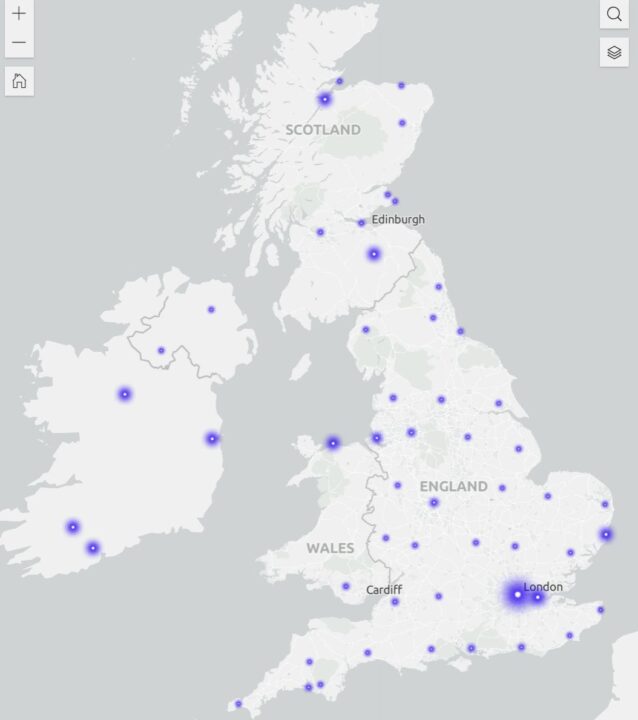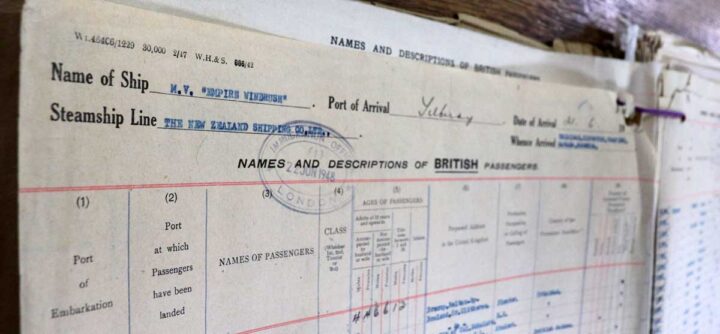
By Lisa Berry-Waite, Migration and Citizenship Researcher, November 2023
This blog looks at a volunteer transcription project which was part of our Windrush 75 programme, where volunteers transcribed data from three passenger lists (the Ormonde, Almanzora, and Empire Windrush). These ships brought Caribbean migrants to Britain in the post-war period. Thanks to the hard work of the volunteers, this data has been used to create a series of interactive maps which trace passengers onwards journeys in Britain.
Lisa has been working on The National Archives’ Windrush 75 programme, as well as researching post-war migration more broadly.
A new resource: interactive maps
Earlier this year, a team of four volunteers completed a project to transcribe data from three passenger lists: the Ormonde, Almanzora, and Empire Windrush. All three ships brought migrants from the Caribbean to Britain in the post-war period. The Ormonde and Almanzora both docked in 1947 and the Empire Windrush arrived in 1948. We were keen to tell a broader migration story that did not just focus on the Empire Windrush, but helped us to understand more about wider post-war migration trends from the Caribbean.
Data transcribed from these passenger lists has been used to create a new resource, Caribbean migration to Britain: A snapshot in time, which traces passengers’ onwards journeys on all three ships once they arrived in Britain through a series of interactive maps. How did the passengers of these three voyages differ? What could looking at the individual migration journeys of passengers tell us?

This blog looks at the volunteer transcription project which made these interactive maps possible. Although only a short transcription project, the volunteers’ hard work has had a significant impact, as it has enabled us to create a more visual way of showing passenger demographics and migration patterns.
The transcription process
Passenger lists are invaluable records as they provide a wealth of information about the passengers onboard a ship, such as their names, ages, occupations, onward addresses, and their last country of residence. This data was carefully transcribed by the volunteers into Microsoft Excel spreadsheets over a six-week period. From here, the data was then cleaned and transported into ArcGIS, a geographic information system software used to create the resource’s interactive maps.

Whilst we hoped to transcribe all three passenger lists, we started with the Empire Windrush. As the volunteers worked so quickly, we were also able to transcribe the Ormonde and Almanzora passenger lists too in a matter of weeks. This allowed us to map the onwards journeys of all three ships, offering a broader insight into both individual migration stories and wider migration patterns.
The volunteers involved
Many thanks to the four volunteers who worked on the project: Pauline Bittles, Vladina Antonie, S. Tek, and Rebecca Dillon. Without their hard work, this new resource would not have been possible.
Rebecca said that her interest in passenger lists sparked her curiosity in the project:
‘I was interested to work on the project because, just the week before, I found my two grandmothers’ names on passenger lists – one in 1906 going out to Australia as a baby and the other in 1953 travelling on the Queen Mary back from the US. Both their lives were shaped in different ways by those sea crossings. And with this new resource, it’s fascinating to see the dispersal of passengers from the Caribbean throughout the UK (and beyond), establishing communities which remain strong today.’
Reflecting on the project, Vladina said:
‘I really enjoyed contributing to the creation of an interactive map through transcribing information contained in the passengers list. The journeys made by Caribbean migrants come to life through these maps, rather than just from text.’
Pauline also shared her enjoyment of the project:
‘I found it fascinating transcribing for the mapping project. The three ships bringing people here to start a new life bought with them a huge diversity of professions and skills, nurses, teachers, electricians, and carpenters to name a few. The project inspired me to read more on the Windrush Generation and to find out more about their journey to Britain.’
Migration journeys and passenger lists are part of so many people’s heritage. Through this transcription and mapping project we hope to show a little more about the ordinary people, of all ages, genders, and backgrounds, who travelled to many different locations, rural and cities, for a huge range of reasons. This snapshot in time, focusing on post-war Caribbean migration to Britain, is just one possible way to use our passenger lists to learn more about migration journeys.
You can find out more about the resource, Caribbean migration to Britain, in this recent blog. The resource is aimed at teachers and pupils studying migration at school, but will also be of interest to the wider public interested in learning more about post-war Caribbean migration to Britain.